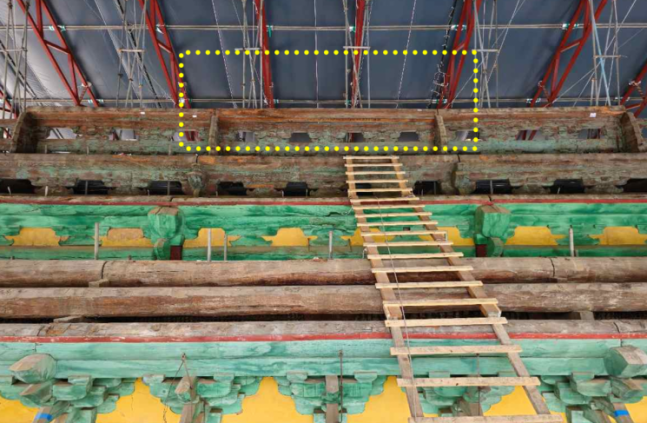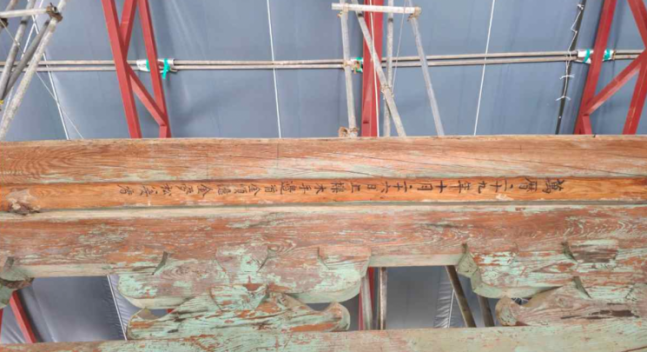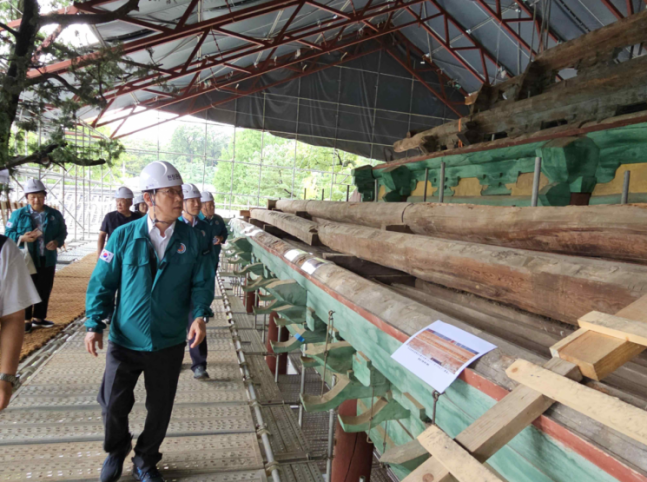Record of Construction-related Information Written in Finial Mortar
Hidden Blue and White Porcelain Discovered in the Ceiling, “‘Seoul Munmyo and Sungkyunkwan’ Dae Sungjeon, a record from 1602, has been found. The Cultural Heritage Administration announced on the 25th that it was found at the lower end of the finial while repairing the roof.”,
,
,

Central section of the finial where the record was found,
,
, ‘The record is a document written in mortar attached to the finial with construction-related information. “Sangryang” refers to a beam placed under the eaves for supporting the corbel (a thin, long rafter that forms the roof structure). A finial is a horizontal beam placed under the eaves. It is placed at the top of the wooden structure.’,
,
, ‘It is the first time that a record of Sangryang has been confirmed on the roof of Dae Sungjeon during repair work. It was not found during repair works in 1869, 1971, 1991, and 2001. There have been several discoveries of Joseon Dynasty architectural traces. In April, during the dismantling of the roof, an 18m-long curved beam made of a single piece of wood was excavated.’,
,
,

Record of Sangryang,
,
, “The Sangryang record includes the date of Sangryang on October 26, 1602, and the names of the carpenters. It reads, ‘Manlye 29th year, October 26, 1602, Kim Sun-yeok, Kim Mong-song, Kang Hyang, carpenters.'”,
,
, ‘According to the Annals of the Joseon Dynasty, Dae Sungjeon was reconstructed in 1407 but was destroyed during the Japanese invasions of Korea in 1592. It was reported to have completed the reconstruction in July 1602. An official from the Cultural Heritage Administration explained, “There is a discrepancy of several months between the Annals of the Joseon Dynasty and the Sangryang record. The names of the carpenters are also not found in other records. Further investigation is needed.”‘,
,
, ‘During the dismantling of the roof, an unidentified blue and white porcelain was discovered in the ceiling that had not been revealed before. According to the Annals of the Joseon Dynasty, bats inhabited Dae Sungjeon in 1704. They continued to dirty the interior of the building and installed banja (a flat ceiling on the upper floor or under the roof of a room) covering. An official from the Cultural Heritage Administration stated, “It is estimated to have been constructed before the reign of Sukjong (1674-1720) and will greatly help in the study of traditional blue and white colors and patterns.”‘,
,
,

Choi Eung-chun, head of the Cultural Heritage Administration, inspecting the record of Sangryang found at the lower end of the finial during the roof repair at Dae Sungjeon in ‘Seoul Munmyo and Sungkyunkwan’ on the 24th.,
,
, ‘The Cultural Heritage Administration opens the repair site every Thursday, and with prior reservation, visitors can hear interesting explanations and see it for themselves. The repair work is scheduled to be completed in February 2025.’,
,
,

